Backing up to what I saw...there's a
gentleman by the named Dinesh Shamdasani.
He is a comic book publisher of high
regard, by anyone who knows good from bad,
and from my experience he is a cunning, hard
working and delightful
human being. He took over Valiant Comics
years back. I did some freelance stuff for
him there, and he earned my respect quick,
fast and in a hurry. He's since moved onto
publishing comics under the label "Bad
Idea". He puts out top notch work, by
top notch professionals. Any quick look at
Bad Idea's offerings is proof that the guy
knows and cares about quality.
I can't say I've kept in touch much,
beyond the "hey, how's things by you?'
every
once in a blue moon, but I do keep an eye on
him because, as I said, the guy knows his
stuff and puts out great work. So...that's
how I saw...THIS
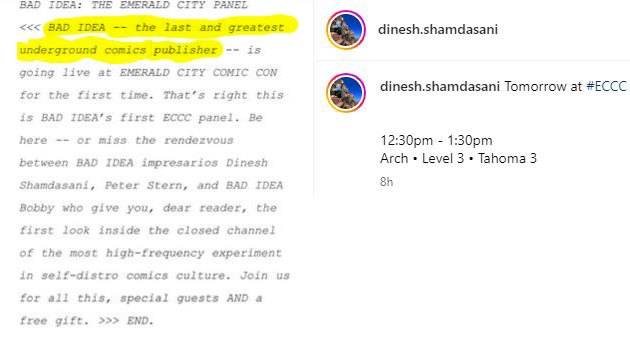
whoa, whoa, whoa....whoa... "underground
comics publisher" ...uhm...what?!
We've all, since the beginning of comics,
thrown around unquantifiable claims- "best
kids comics on the rack!" "worlds greatest
comics magazine"...."king of dark humor".
There's no real measuring stick for any of
that, it's all bravado. You make the claim and it's up to the
reader if you lived up to it or not.
BUT....the term underground comics is
SPECIFIC.
"Underground comics " refers to comics, that
because of their CONTENT...edgy, subversive,
counter culture ideas, controversial subjects,
controversial imagery, things like that...they were not able to get distributed
through the standard mainstream means,
sometimes not even produced through standard
mainstream means, and/or
caused problems for those who dared sell
them. That term comes with some merit. Implies...
courage... for lack of a better word, to
continue forward despite having many
doors closed to you and in the face of
possible backlash
from mainstream type people and/or the powers that be,
because they will likely react aggressively
to the CONTENT you choose to create.
Bad Idea publishes work by brand
name pros, some of whom are borderline
legendary in the industry and not a single thing they put
out is likely to draw the wrath of an
average reader, parent, or make a store
concerned about having it's content on the
shelves.
Those are damn fine looking works...but they
ain't underground comics.
The specious-ness of that claim is about to
become clear to you, as we go down a very
strange road in comic book history
Let's start by going WAY back to grand daddy of
underground comics, the Tijuana bibles.
These were 3x5inch, 8 page, one or two
colors, and printed on the cheapest stock
available. They had varying degrees of
quality of work and even of production. Most
of them were direct parodies of
mainstream cartoons/comics/characters, and
some were just parody of the genre or
an amalgamation of different cartoons.
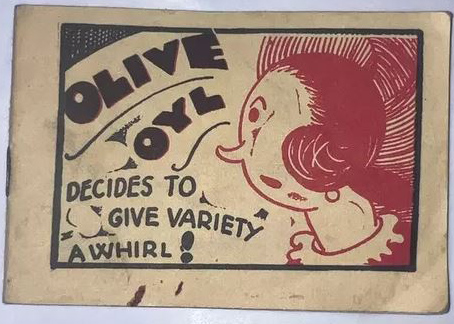
We're
talking the 20s and 30s at their apex. and
they were...well, with the imagery in my head
of model T fords driving around, men wearing
spats and Charlie Chaplin in the movie
theaters, I know my
mind was blown.
***NOTE- You can see an uncensored version
of this blog by clicking
here. I'll warn you
right now, though, it's worse than you
think and
way worse as we get into the 80s/90s ".
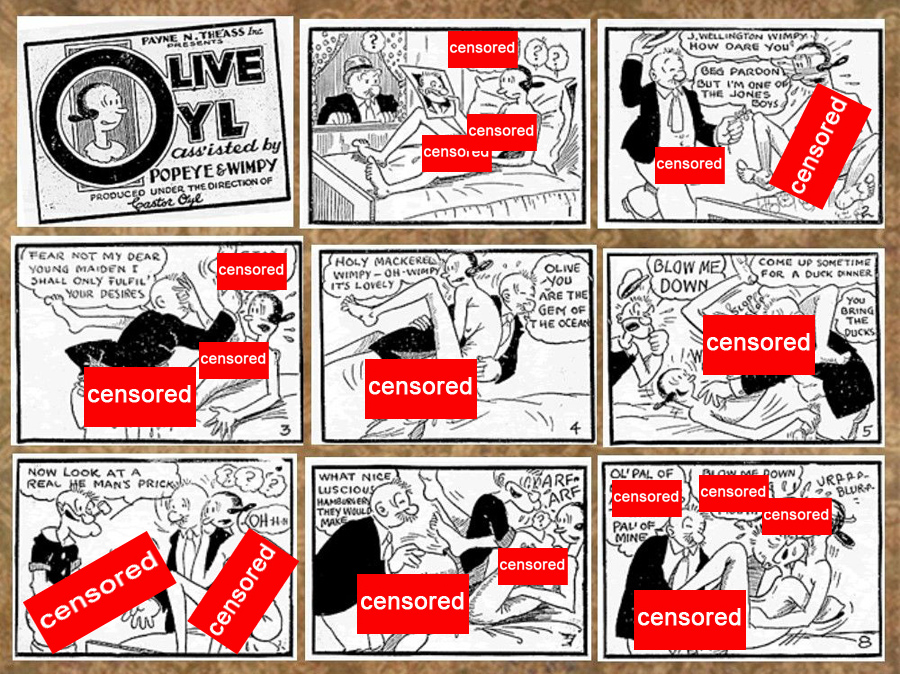
I almost threw up..anyone else? Here's
another.
.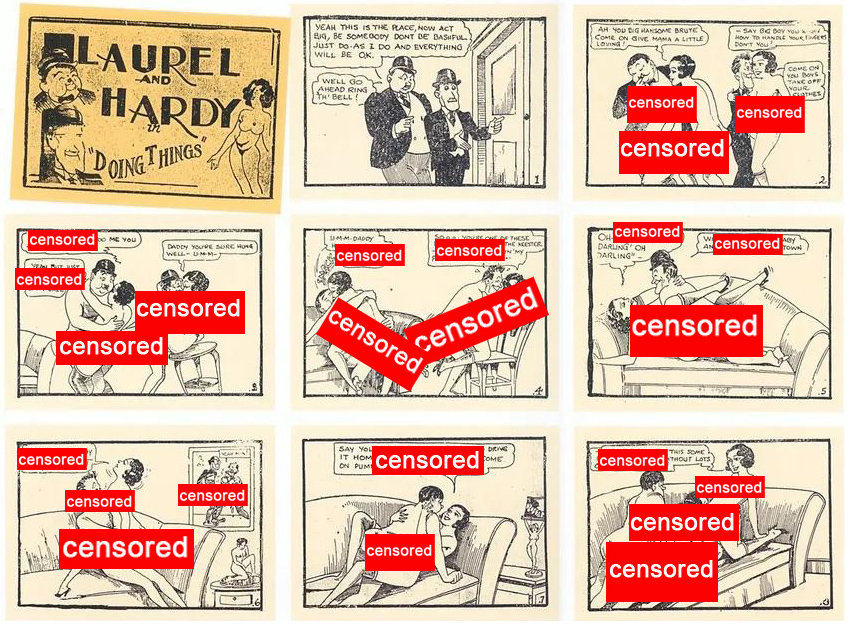
***another side note here- Obscenity aside,
these illustrations are pretty well on par
with the illustrations being published by
the actual syndicated
cartoonists in newspapers at the time. The
Laurel and Hardy parody is actually a bit
better than most of them were. Someone, of
considerable skill, spend several hours
drawing Laurel and Hardy screwing flappers.
You wanna know who?...nobody knows! The
reason for that will be clear shortly.*
When you take into account this was an era
not that a far removed from WW1, in the tail
end of prohibition, and going headlong into
the great depression...these TJ Bibles
actually seem more fitting. This was
an era of bootlegging, gangsters, flappers
and hobos. So with that in mind. Those
comics above actually seem more appropriate
for the times, than this...

"oh..ha ha, what a delightfully funny
joke about being lazy at work, ha ha. Wish I
had a job, but it's the great depression and
every week I have to find a way to not
starve to death."
There's a lot of subtext that's going on
with each era of underground comics, and you
could write a whole sociology paper on it.
I'll try to stick with the nuts and bolts of
Underground stuff and not get philosophical.
I'll say this though- In every era of "pop
culture" in this country, you've had people
content with whatever is mainstream
entertainment, the example in this era,
Blondie and Dagwood. And you're going
to have people (
Creatives and audiences)
who look at that stuff and say
"yeah...that ain't doing it for me".
This happens especially in times of change,
upheaval, cultural stressors.
Conversely there's the segment of the
population that is perfectly happy with the
status quo, deals with change by attempting
to ignore it or hoping it goes away and is not interested in any
alternative taking root. People, don't like
feeling powerless, and if there are giant
stressors and changes going on that they
cannot affect, some of them go hard down on
affecting the little things that that can. Which is
why these throw away comics, became the
subjects of state and federal investigations.
Arrests were being made, warehouses were
being raided, equipment was being seized.
At one point the FBI was making raids and
confiscating TJ bibles by the thousands,
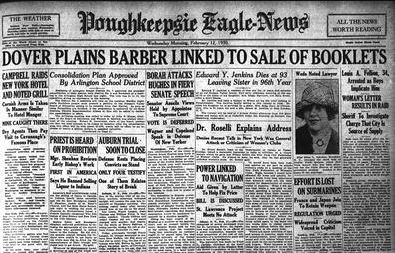
...at a time that the morality police
were in such power as to be able to take
away booze, they sure were not going to let
a bunch of pornographic comics get
distributed.
And there was no internet,
remember...never underestimate the reach of
people who want to ruin fun.
To
be fair they were
violating pornography and obscenity
statutes, though with John f*cking Dillinger
on the loose, it all seems like a waste of
manpower.
Even though
there was a huge market for TJ bibles (print
runs in the hundreds of thousands)
they were not
going to be able to sell these on the
newsstand.
These where literally black-market products,
and passing through all the same avenues of
distribution as bootleggers .
They sold them under the table in
places like speak
easies/barrooms, bowling alleys, garages,
tobacco shops, and burlesque
houses...anyplace where people weren't
skittish and knew how to keep their mouth
shut. They'd print them up ship and them
in bulk through the post office, or by rail
or truck to the black-market
hub of a given city, where they would be
picked up by whichever business owners were
happy to acquire illegal goods as long at they
sold.
...and that is the root of underground
comics.
The TJ bibles managed to keep going by hook
or by crook for a long time, then ww2
happened and machinery, paper, talent, means
of shipping, any everything else was a lot
harder to come by for even legit publishers.
Although they did keep getting printed into
the 50s, they had honestly pretty well petered out during the
40s.
But...stressors and changes to the culture
continued.
And so concepts, subversive by comparison to
what was the status quo, did arise...
Those (above) are a fair sample of the work
published by EC Comics Publishing.
EC comics are not, by anyone's measure,
"underground". They sold millions right on
the news stands. BUT the backlash they got
was important to setting the table for the
next wave of underground comics, so here are the
high points of EC's hand in the matter.
in the late 40s early 50's Horror comics were big, and EC
comics was the largest and best publisher of
that genre. and they were...awesome.
BUT....as always, "there where those who
did not like our hero".
There were giant protests by the usual
personality types, ( we call them Karens,
now) it's the same
personality in a different body in a
different part of the timeline. Or perhaps
the daughters of the people who wanted the
FBI to spend time stopping TJ bibles from
being bought.
Believe it or not, this time there were
CONGRESSIONAL HEARINGS...on comic book
content...I sh*t you not.
That's Bill Gaines on the right, the
publisher of EC Comics and a legend worth an
entire blog on his own. Eventually the comic book industry itself set up a
list of rules and a half assed board to
monitor
itself. You had to submit your book to the
board, and if they decided your book was not
going to lead any children to immorality you
could put this logo on it.
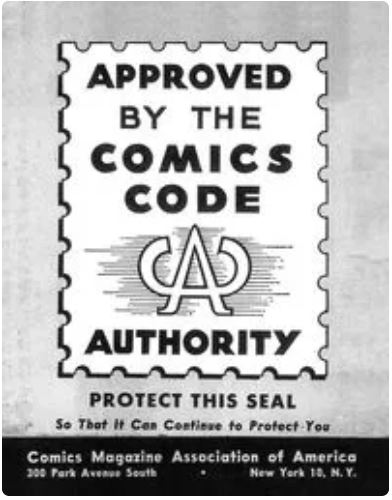
And if it DIDN'T have that logo...good
f*cking
luck getting any distributor to touch it
with a ten foot pole.
Magazines, however did not have to have any
such logo or restrictions and that is why
EC Comics turned Mad comics into
Mad
Magazine. So technically, maybe, you could
call Mad's first few issues in comic book
format, an Underground
comic. The overall point though is the
Karens kept comics from
crossing any lines that mainstream didn't
approve of via the comic code/putting
pressure on the distributors. And with the
era of speakeasies long gone as well as any
real interest in comics by black-market
types, subversive comics were more or less
non existent or at the very least irrelevant....
UNTIL the next change in the
zeitgeist, the era of this country known as
the 60s
.This is the time of filthy hippies and
drugs and sex and rock and roll, the civil
rights movement, the Vietnam War and...
a segment of people were looking for more
than batman and robin, Casper, and Archie.
A new rise in talent had stories to tell to
a new audience that was bored with the usual pap.
Most of these comics had, well...lots of
drugs and sex, of course. It also had a
rather distinct look, mostly pioneered by
the legendary Robert Crumb. It was a strange
mix of a cartoony foundation but with very
workmanlike shading. If we gave it some
thought, we could probably suss out how that
was a allegoric mirror of the culture
somehow.
I've said it
before and I'll say it again about the 60s
undergrounds stuff..."i don't
get it". I just personally never
liked any of that stuff, and every time I say
that I have to listen to a lecture from
someone who does.
Look...it's fine, they clearly had some skill
and I guess this was all funny at the
time. I just don't get it.
In any case, they didn't bother with any
comics code, nor did they even bother
thinking of putting these on a newsstand or
bookstore shelf. They went right to were the
audience was..head shops, concerts, record
stores...points of sale where the proprietor
was of the "screw the man"
disposition, and
thus happy to sell subversive comic
books. And they sold BIG and many were so well
done that they inspired a generation of
talent. Not me...I never heard of any
of this until I was already making comics, I
frankly I'd be just fine never knowing they
existed. I just...I hate them, all the
characters look gross and make me want to
take a shower.